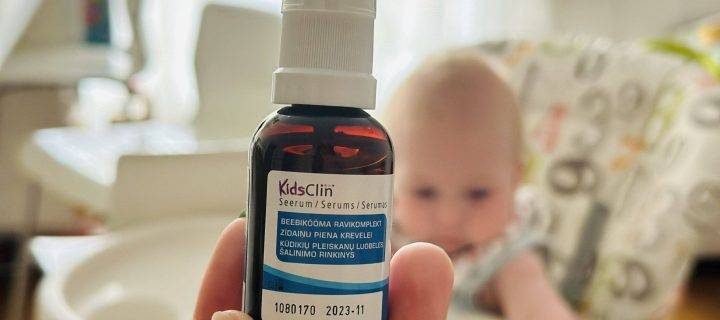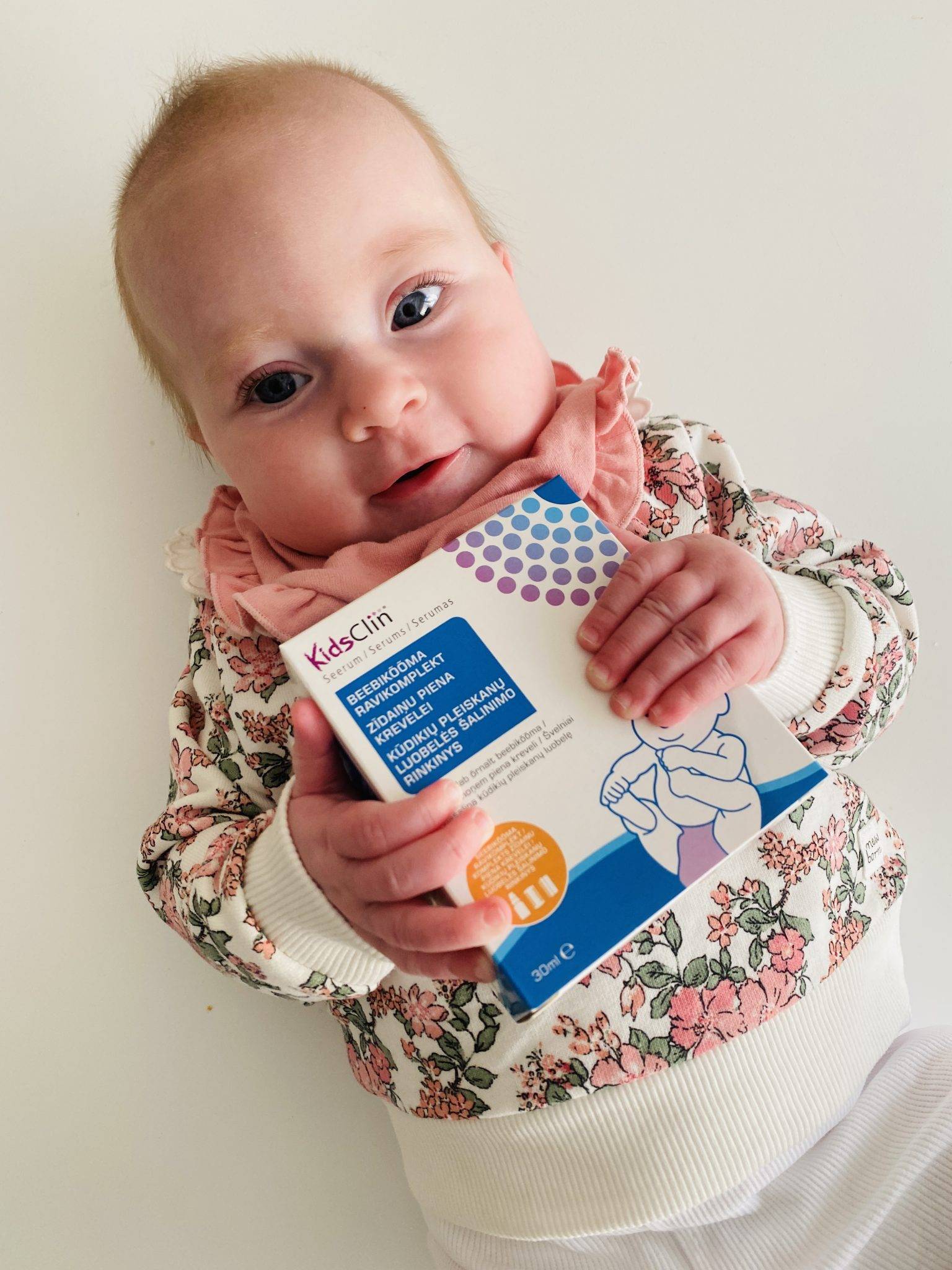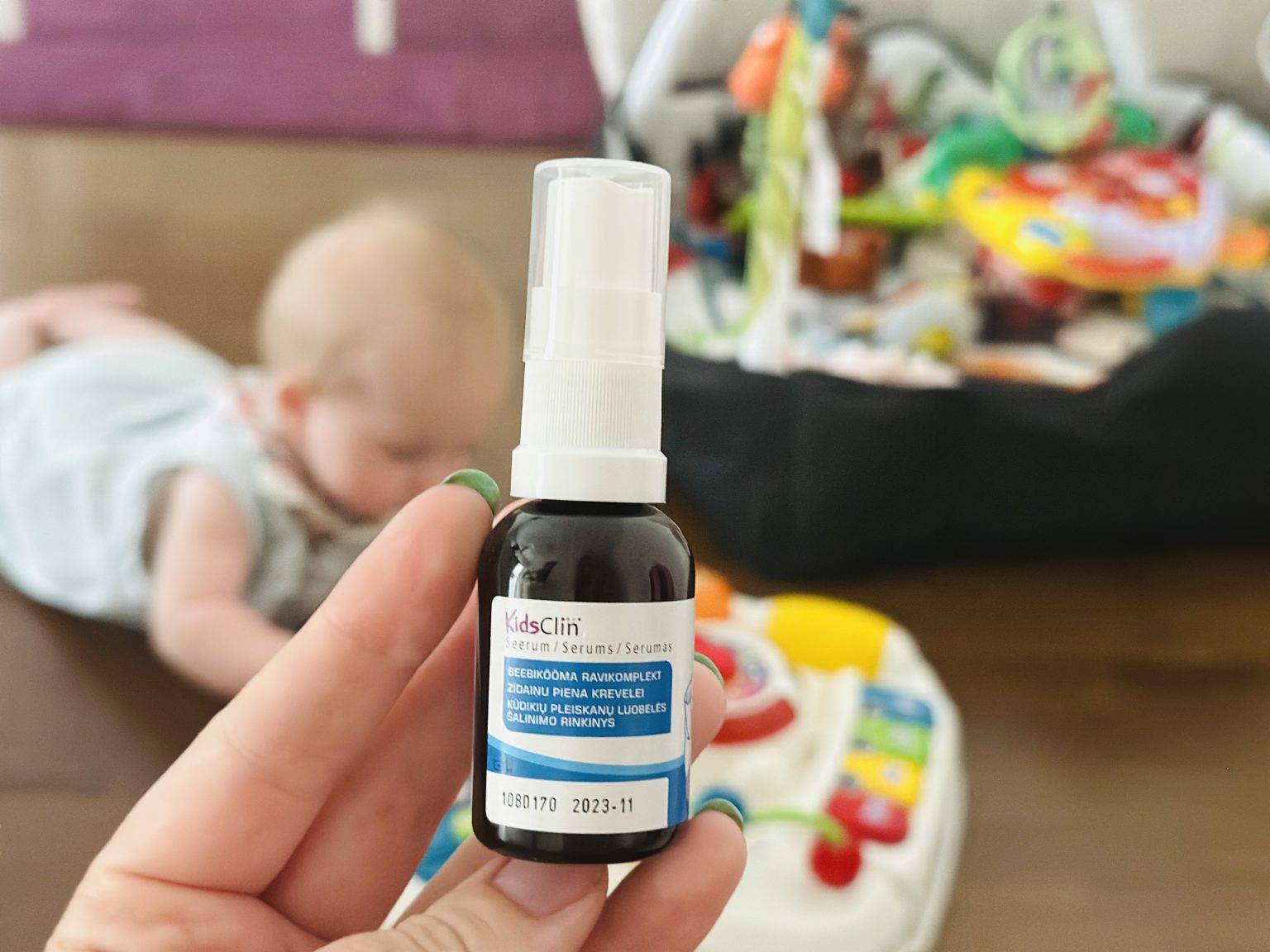Mothers who see dandruff on their baby’s head are often worried – is it normal, or is the baby’s dandruff a sign of a disorder? Should it be removed or left? We want to reassure you – it’s a normal part of the first year and it’s easy to get rid of.
Agnė, one of the founders of “Travel 4 kids”, shares her tips and information about baby’s cradle cap. Baby’s cradle cap is completely normal. Paule developed it around the second month and we eradicated it without any problems, thanks to certain measures.
Baby’s cradle cap – facts about it
Cradle cap (infantile seborrhoeic dermatitis) is defined as the appearance of yellow or brownish dandruff mainly on the top of the head. The area covered by the dandruff can vary considerably, depending on the baby’s individual body conditions. Thus, a baby may have just one square centimetre of cradle cap, or it may have almost the entire top of the head covered like a hat.
However, it is not only on the top of the head that a shell can appear, but also on the eyebrows, eyelids, behind the ears, in the crease of the nose, on the neck, in the diaper area, on the knees, in the armpits or in the elbows.
Crdale cap is thought to be caused by excess sebum secretion (in the sebaceous glands). IMPORTANT! Cradle cap is NOT caused (as is often thought) by poor hygiene or allergies! In fact, cradle cap is seen as a very common condition, occurring in approximately 50 percent of all babies. So, of course, there are some babies who never develop cradle cap.
Baby’s cradle cap – how to deal with it?
- Don’t be in a hurry to scratch it, as this can cause damage to the scalp – a wound may appear.
Do not scratch it with your fingernails, as it can get infected. - For most young children, dandruff goes away on its own, usually with daily brushing with a soft baby hairbrush.
- If you have a large area of cradle cap, or if you can see that it doesn’t go away naturally over a few months, or even if it’s getting thicker, try the 3 gentle ways to remove it below.
3 effective ways to remove the peel:
- Normal daily combing. Although it may seem trivial, we rarely think about combing our baby’s still bald head. Because it seems strange to comb a bald head. However, this gentle brushing with a baby brush that has soft bristles reduces cradle cap and massages the little head.
- Oiling/greasy cream – washing the head – gentle combing. If normal combing does not reduce the cradle cap, you can try this popular home remedy for removing it. One time is usually not enough, so just be patient and repeat for about a month. Or until the last traces of the cradle cap are gone.
- Special cosmetic products for removing the peel. If the usual home remedies don’t work, or if you simply prefer to relying on specialised products, you can certainly find a safe, gentle cosmetic alternative that will help you remove the cradle cap more easily and, in many cases, even faster. The principle of action is usually similar to that of an oil – apply before bathing and then gently comb out. There are also some that simply need to be applied/sprayed daily. Specialised products quickly and effectively soften the hair shaft and make it easier to remove by gentle brushing.
Homemade way to remove baby’s cradle cap
- About an hour before bathing, apply oil to the cradle cap area of your baby’s head. If you have a special oil for babies, that’s fine, if not, that’s fine too. Any natural oil (unrefined, unperfumed), such as pure olive oil, is fine. Grease the scalp quite thickly. You can also apply a creamy emollient if you have one at home.
- After bathing, use a baby comb to gently brush the scalp, BUT do not scratch, or try to ‘scrape off’ sticky dandruff.
- After bathing, the scalp will slowly untangle with each combing. Unfortunately, one or more times may not be enough. In most cases, the flake will disappear after a few weeks of regular use of the oiling-washing-combing treatment.
- If the dandruff flake reappears after a while, repeat the procedure. It is really painless and harmless for the child if you do it gently and patiently.
The best specialised cradle cap remover we have tested
Although we both used the simplest home remedy with our first-born – applying baby oil before bathing – with our second children we wanted to try cosmetic products, which proved to be more effective than oils for both families. But this is, of course, subjective, as different products are of course suitable for different children.
Our latest discovery, which we tested with our youngest Paulė, is the “KidsClin® Cradle Cap” Serum Baby Dandruff Removal Kit 3IN1. It’s not only a natural cosmetic product (very effective, by the way), but also gadgets that make it easier to use. This kit includes:
- 30 ml bottle of “KidsClin®” deep-acting serum with nozzle
- Brush with soft sponge
- Combs
- Information leaflet with instructions.
The “KidsClin®” serum absorbs into the skin and just gently dissolves the sticky layer of dry sebum. It further reduces the loss of moisture through the skin and restores the skin’s protective barrier function, thus preventing the reappearance of peeling. The enclosed brush and comb are used to remove dandruff that forms with the cradle cap.
We really liked this product because of its ease of use – even though it needs to be sprayed/applied daily, the effect is visible – the cuticle is much softer and can be brushed out a little each day.
How should I use KIDSCLIN® CRADLE CAP?
- Remove the protective cap from the “KidsClin®” spray bottle.
- Spray 2 times on your palm and apply “KidsClin®” serum (massage) to the area where the dcradle cap is located.
- Repeat if the area of cradle cap is large, e.g. the scalp. It is important to apply enough “KidsClin®” to the skin.
- To remove sticky dandruff, use the sponge side of the brush, massage the scalp VERY CAREFULLY and remove the dandruff with the rough side of the brush. Use the comb to REMOTELY remove dandruff from the child’s hair. Remember that the child’s scalp and skin is very soft.
- Apply “KidsClin®” serum every morning and evening until the cradle cap is gone. This usually takes 1-4 weeks.
If a dandruff patch has formed around the baby’s eyes, “KidsClin®” can be sprayed onto a cotton bud to help apply the product to the area and prevent it from getting into the baby’s eyes. The residue of “KidsClin®” on the palms of the hands can be used to massage other areas of the baby’s skin as it prevents the skin from drying out.
Most importantly, you can trust this product because it contains only natural oils and ingredients that are gentle on baby’s skin.
When should I be worried about a cradle cap and see a doctor?
- In fact, it is always better to consult your child’s doctor before taking any self-treatment measures. Simply ask your paediatrician to examine the head and assess the cradle cap at your next appointment.
- If you have even the slightest suspicion about the condition of the scalp, consult a specialist dermatologist, preferably one who has experience with babies.
- Concern should be expressed when the baby’s head and occiput are covered with a thick white cradle cap, with blood even visible when the flakes are lifted. This is a severe form of seborrhoeic dermatitis. It is then necessary to seek urgent medical attention.
- If the skin is itchy, scaly and inflamed underneath the cradle cap, it should be treated.
- If the skin is red and dandruff appears on the face, neck and behind the ears, it is also necessary to see a doctor.
- Sometimes seborrhoeic dermatitis is accompanied by atopic dermatitis. If the rash is very severe, a doctor should also be consulted.
- Seborrhoeic dermatitis is usually not seasonal, but can be exacerbated by heated indoor air. If the flare-up only occurs in spring, it is suspected to be atopic eczema.
- If cradle cap appear in a child over the age of three, a skin doctor should be contacted. This cradle cap can be a sign not only of seborrhoeic dermatitis but also of scaly dermatitis. Unfortunately, it is becoming increasingly common to find scaly skin in young children.
- If the cradle cap persistently reappears, redness, itching, etc., it is essential to seek medical attention. Treatment is quite effective and the medicines are prescription-based.







